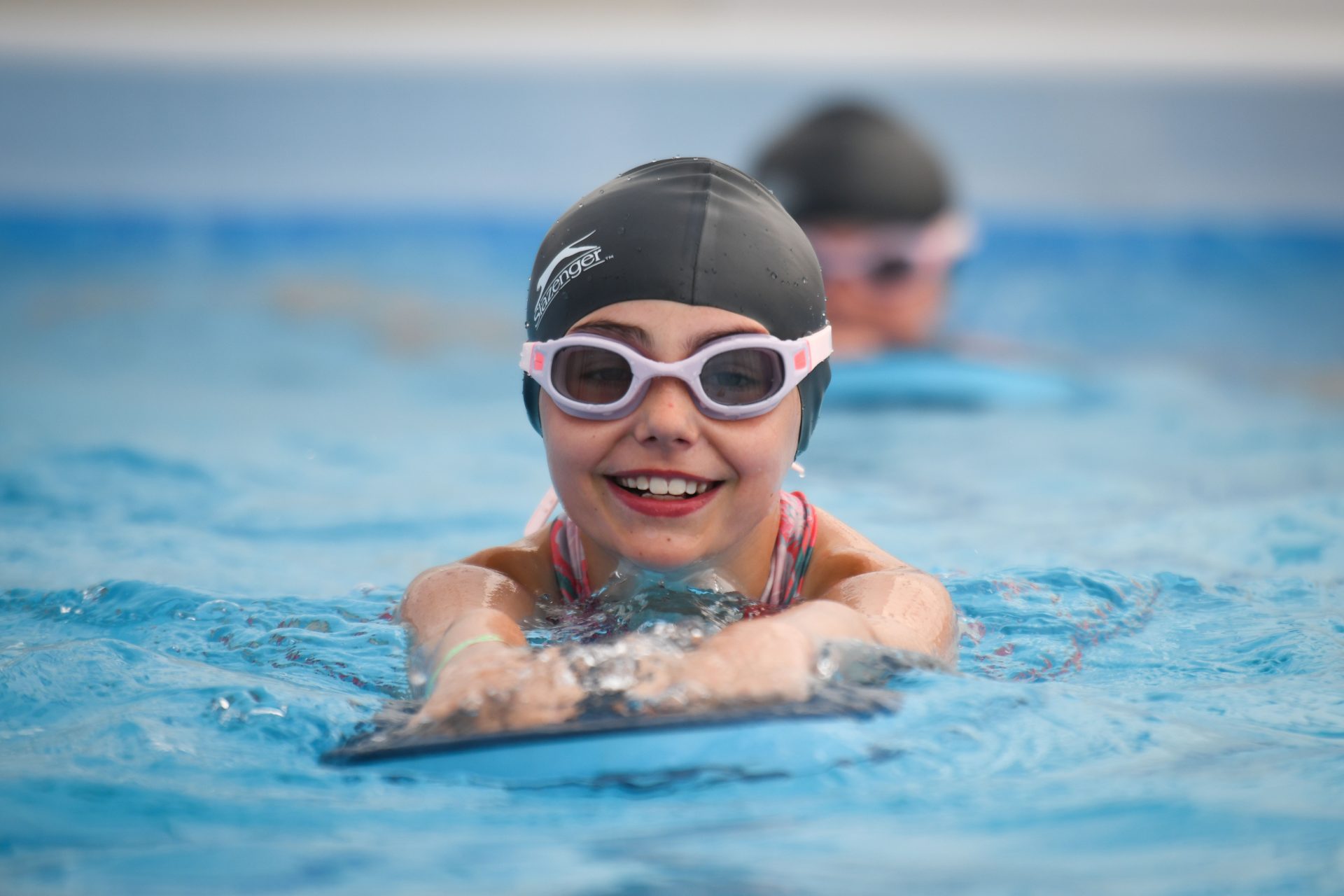Introduction
Picture your childhood summers: Did they involve splashing around in a local pool, the cool relief of a lake on a hot day, or the rhythmic waves at a sandy beach?
For many, these cherished memories encapsulate the joy of water activities. Now, imagine being unable to jump in and enjoy the water for one simple but crucial reason – you never learnt how to swim. Shockingly, an estimated 1 in 3 children in England leaves primary school without basic swimming abilities, transforming an otherwise joyful activity into a potential hazard.
Why is this so? Swimming, more than just a recreational activity or a competitive sport, is a life-saving skill that every child should have the opportunity to learn. Yet, swimming education often takes a back seat in today’s fast-paced, academic-oriented world. In this blog post, we delve into the importance of swimming education in England’s primary schools, the current state of swimming education, the numerous benefits swimming brings to children, and the role primary schools play in fostering this critical skill. We’ll also discuss different approaches to swimming education, helping us understand how we can better equip our children for safe and enjoyable interactions with water.
So, grab your metaphorical floats and goggles as we dive headfirst into the world of primary school swimming education. Let’s make a splash!
Why swimming education is essential
To begin with, let’s clarify what we mean when we talk about ‘swimming education’. It goes beyond the ability to do a front crawl or a backstroke. Swimming education encompasses understanding water safety, performing a safe self-rescue, and being familiar with various swimming techniques.
A sobering statistic accentuates the necessity of swimming education: drowning remains a leading cause of accidental death in children in the UK [Royal Life Saving Society]. Alarmingly, research by Swim England reveals that only 52% of children are leaving primary school as confident swimmers, capable of fulfilling the national curriculum requirement of swimming at least 25 metres unaided [Swim England, Annual School Swimming and Water Safety Review 2020]. There needs to be more clarity between the importance of these skills and their prioritisation in our primary schools.
Moreover, we must recognise that the significance of swimming education extends beyond its life-saving potential. Regular swimming sessions from a young age can offer significant physical health benefits, including improved stamina, flexibility, and strength. The unique low-impact nature of swimming makes it a highly inclusive form of exercise, suitable for children of all abilities and fitness levels [Health and Wellbeing Benefits of Swimming. Swim England’s Health Commission Group].
Importantly, swimming also brings substantial mental health benefits. The sense of buoyancy and the rhythmic, focused movements involved in swimming can have a calming effect, reducing stress and anxiety levels. There’s even evidence to suggest that swimming can enhance mood and self-esteem[Bupa].
Therefore, providing swimming education in primary schools stands at the intersection of child safety, physical health, and mental well-being, warranting our undivided attention and action.
The current state of swimming in primary schools
Despite the compelling reasons we’ve just discussed, swimming education in primary schools is not as strong as we might hope. It’s often considered one of the ‘forgotten’ areas of the National Curriculum.
Recent reports paint a worrying picture. Swim England’s Annual School Swimming and Water Safety Review 2020 reveals that nearly half of the children in England cannot swim the statutory 25 metres by the time they leave primary school. In practical terms, they might not have the skills to save themselves if they unexpectedly end up in the water.
A significant obstacle to improving this statistic is access. Very few state schools have swimming facilities. This necessitates organising off-site swimming lessons, which brings logistical challenges, from transport arrangements to fitting lessons around the school timetable and other curriculum commitments.
Then there’s the matter of cost. Schools often have to balance the financial implications of providing swimming lessons against other resource needs. As a result, swimming instruction may receive less priority, leading to insufficiently trained pupils and the continuation of alarming statistics.
At the teacher level, more confidence or expertise is often needed in delivering swimming and water safety lessons [Teacher training is ‘vital’ to successful school swimming lessons. Swim England]. While there are exceptional cases of teachers who’ve undergone additional training, these are sadly more of the exception than the rule.
This presents a clear and urgent need for our society to address how we handle swimming education in primary schools.
The Benefits of Swimming for Children
The benefits of swimming for children are manifold and go beyond merely mastering a stroke or two. It’s not just about ticking a box on a curriculum requirement but also about providing a holistic approach to physical education and instilling crucial life skills.
Let’s break it down:
- Physical health and development
Swimming is a fantastic way to get children moving and active. It’s a full-body workout that helps improve strength, flexibility, stamina, and coordination. The British Heart Foundation emphasises that swimming is an excellent way for children to stay healthy and improve their cardiovascular fitness.
- Safety and Survival Skills
Given the rich aquatic environment in the UK, children must learn how to be safe around water. Understanding the basics of water safety and mastering swimming can save lives. It’s as simple as that. The Royal Life Saving Society UK reports that drowning is the third highest cause of accidental death of children in the UK.
- Mental Well-being
Swimming can contribute significantly to a child’s mental well-being. It’s known to reduce stress, improve mood, and boost confidence. Swimming can also enhance concentration and academic performance.
- Social Skills
Lastly, swimming fosters a sense of camaraderie and team spirit. It provides opportunities for children to interact with peers in a non-classroom setting, promoting social skills and friendships.
Different methodologies or approaches
There is no one-size-fits-all approach when it comes to teaching swimming and water safety in primary schools. Here are a few teaching methodologies employed with varying degrees of success.
- Traditional method:
The traditional approach to teaching swimming in primary schools often involves off-site lessons at a local public pool. Children are generally grouped by ability, with instructors focusing on technique and stamina. While this method has its merits, the challenges of off-site travel, limited pool time, and large class sizes can often lead to insufficient outcomes.
- In-school swim lessons:
Some innovative schools have started hosting swim lessons on their premises, either in permanent or temporary ‘pop-up pools’. This approach eliminates travel time, allows for flexible scheduling, and can create a more comfortable learning environment for the children. However, it does require careful planning from schools.
- Community partnership:
Schools sometimes partner with local community centres, private clubs, or private schools to provide swim lessons. This approach allows for resource sharing and access to better facilities. However, scheduling and coordination can be complex.
- Integrated Water Safety Education:
This approach combines practical swim instruction with classroom-based water safety education. Schools can complement and enhance the practical skills learned in the pool by teaching children about water hazards, safety rules, and emergency response in a classroom setting. This comprehensive approach promotes a deeper understanding of water safety but requires a well-rounded curriculum and skilled teachers.
Each of these approaches comes with its own set of advantages and challenges. Schools must consider their unique circumstances and resources when choosing a method that best suits their needs and objectives. The ultimate goal is to provide high-quality swimming and water safety education that prepares children for a lifetime of safe and enjoyable interaction with water.
Conclusion
Swimming education is more than just an opportunity for fun and physical development – it’s a life-saving skill every child deserves to learn. Despite the challenges and limitations currently facing swimming education in English primary schools, it’s clear that this critical aspect of the curriculum can’t be overlooked or undervalued.
The variety of teaching methodologies allows schools to find an approach that best fits their circumstances and meets their pupils’ needs. Whether using traditional methods, incorporating in-school lessons, partnering with the community, or integrating classroom-based water safety education, the primary goal remains the same: ensuring every child acquires the essential skills to be safe and confident around water.
We have a collective responsibility towards our children’s safety and development, and there’s no better place to start than in our schools. The value of swimming and water safety education is unquestionable. It’s now upon us to ensure its effective delivery, as the benefits will ripple through generations, ensuring a safer and healthier future for all our children.
Additional resources
The Primary School Swimming Review provides a comprehensive scorecard that allows schools to evaluate their current swimming provision and offers insightful recommendations.
For schools that find it challenging to provide a swimming education that fulfils national curriculum standards, Swim:ED offers an innovative pop-up-pool solution and teaching programme that provides a complete and secure learning experience right on a school’s playground. Progress is tracked, and achievement levels are documented to help schools meet national curriculum goals and ensure children are more competent, confident and safer in the water.
By arming ourselves with knowledge and the right tools, we can collectively enhance swimming and water safety education in our primary schools, better preparing our children for a safe and active future. Let’s make every stroke count!




